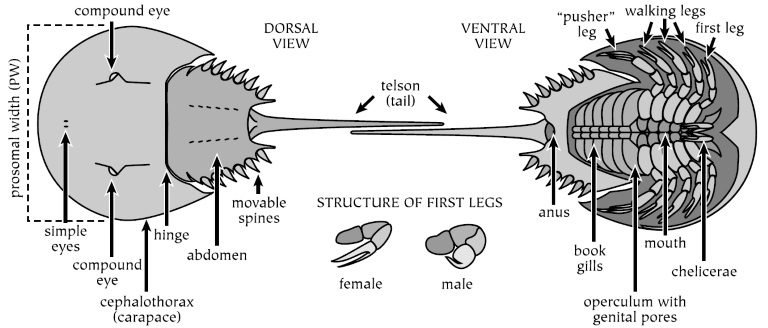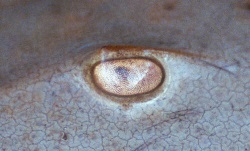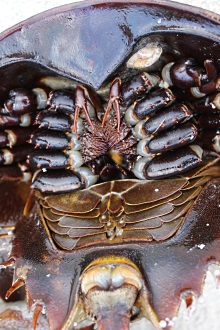Horseshoe Crabs
Horseshoe crabs have existed for more than 400 million years, surviving dinosaurs, ice ages, and rearrangement of the continents. Today, this ancient animal has both ecological and economical important in South Carolina. Its eggs serve as a vital source of food for migrating birds and extracts from its blood are used extensively in the biomedical industry.
Help us learn more about our horseshoe crab population in South Carolina with our survey! We know that horseshoe crabs use the South Carolina coast to lay eggs, or spawn, and our biologists need your help identifying which areas the crabs are using this year. Your data will help us better understand these amazing animals and make informed decisions about our shared natural shorelines.
Taxonomy and Distribution
Horseshoe crabs are not true crabs but are arachnids, meaning they are related to spiders and scorpions. True crabs have two pairs of antennae, a pair of jaws, and five pairs of legs with one set of claws. Horseshoe crabs lack antennae and jaws, and have six paired appendages with five sets of claws. They also possess spider-like appendages used for crushing and grasping food. Of the four living species of horseshoe crabs only one inhabits the Atlantic Ocean, ranging from northern Maine to Mexico. They are most abundant from New Jersey to Virginia with the largest population in Delaware Bay, where the coarse sandy beaches are ideal for spawning.
In South Carolina, horseshoe crabs use various marine habitats for feeding, spawning and development. Adults migrate inshore in the spring and early summer to spawn on beaches and in salt marshes. In the fall, they move to deeper ocean waters or to the Atlantic continental shelf to overwinter.
Anatomy and Behavior
Horseshoe crabs, with their prehistoric looking body and long, intimidating tail, appear dangerous but are harmless. The helmet-shaped carapace provides protection, and they use the long tail to right themselves when overturned in the surf. The large, domed shell protects the internal organs and allows the crab to swim easily and dig into the sand. The telson, or tail, contains no stinger, but it does have photoreceptors that allow it to sense light. Do not pick a horseshoe crab up by its tail - the tail is very sensitive and easily injured.

On top of the body, horseshoe crabs have two compound eyes, similar to those of many insects. These unique eyes contain over 1,000 light receptors, more than any other animal, and allow horseshoe crabs to see hundreds of copies of the same image. An additional eight eyes run along the sides of the body. These simple eyes measure day length, and the intensity of visual and ultraviolet light. This combination of ten eyes allows horseshoe crabs to see at night as well as during the day.

The first set of appendages closest to the horseshoe crab's mouth are chelicerae and are used for feeding. The other five pairs of appendages are legs, or pedipalps, all of which have claws. In mature males the first legs, which resemble boxing gloves with a hook, are modified to grip the female during spawning. Horseshoe crabs use their first four clawed legs to lift them off the ground, and then use their pusher legs to propel themselves forward. When a horseshoe crab needs to move quickly, it can force water out of its book gills under the body, and jet away.
Feeding
Horseshoe crabs feed on a variety of slow-moving bottom-dwelling organisms, including shellfish and marine worms. They also eat decaying animal matter. They use their legs to search for food on the ocean floor, and spines around their mouth to “smell” food, and can crush the hard shells of mollusks, worms and other invertebrates. Like birds, they have a gizzard containing small bits of gravel and sand to grind food.
Life Cycle and Reproduction
Horseshoe crabs can grow to two feet long, and live up to 25 years. In warmer waters within their geographic range, they remain active all year, but in cooler northern regions, the crabs burrow into the mud and become inactive during the winter. Horseshoe crabs reach adulthood at nine to twelve years old. Like all animals with an exoskeleton they must molt to grow. A male reaches maturity after his sixteenth molt, during which he develops modified front claws for mating. The female, usually about 30% larger than the male, reaches maturity at her seventeenth molt.

Underside of a male horseshoe crab
Horseshoe crabs along the east coast of the U.S. spawn primarily during May and June. They often spawn during the night of a full moon, with a high tide that allows them to easily crawl onto the beach to lay their eggs. Males migrate to inshore waters first, then use their modified front legs to hook onto the arriving females. The attached male and female move on to shore, and the female digs a small hole where she deposits strands of dark green eggs. As she lays her eggs in the nest, the attached male releases his sperm and fertilize her eggs. Sometimes, unattached, or “satellite,” males also fertilize the eggs.
Horseshoe crabs usually nest between the high and low tide marks on the beach which protects the nests from harsh wave action. Females lay about 4,000 eggs in each nest, and dig five to seven nests in one visit to the beach. Each female returns to shore multiple times in one year, until she has laid all of her 80,000 to 100,000 eggs.
Incubated by the sun, the eggs hatch in two to four weeks. The hatchlings dig up through the sand at high tide, allowing the waves to carry them out to sea. They look like mini adults, but have no movable tail and no working compound eyes. After 21 days, they settle to the bottom where they remain for the rest of their life. As juveniles, young horseshoe crabs stay in shallow, nearshore waters, feeding on calm tidal flats. Young horseshoe crabs molt three to four times a year, molting less frequently when approaching adulthood.
With less frequent molts, horseshoe crabs attract other marine invertebrates which attach to the crab's exoskeleton. Horseshoe crabs become "walking hotels" with a wide variety of creatures including crustaceans, mollusks, bryzoans and even a type of planarian living on their shells.
Ecological Importance
Eleven species of migrating shorebirds replenish their fat supplies with horseshoe crab eggs on the birds' migratory journey to northern breeding grounds. The birds arrive early in summer during peak horseshoe crab mating season, from mid-May to early June. When digging their nests, female horseshoe crabs often dig up existing nests, bringing those eggs to the surface, and making them available to shorebirds. Because these eggs are no longer viable, the birds have no adverse effect on the horseshoe crab population. Without horseshoe crab eggs, some shorebird species may not get the critical nourishment needed to complete migration. Some species of migratory birds can triple in weight during the weeks they spend feeding on horseshoe crab eggs.
Additional horseshoe crab predators include many fish and invertebrates, which feed on horseshoe crab larvae. Adult horseshoe crabs are a favorite food of sea turtles, including loggerheads. Horseshoe crabs avoid predators by being most active at night. Additionally, the spines on the sides of their shell may provide them with some protection from predators. Beyond their role in the marine food web, horseshoe crabs also benefit the environment as they move along the sea floor, disturbing the top layer of sand and allowing air to mix in to make it more habitable for other animals.
Horseshoe Crabs and Man
Between 1850 and the 1920s, horseshoe crabs were heavily harvested for fertilizer and livestock feed. By the 1950s through the 1980s, horseshoe crab harvest slowed and even ceased at times. In the 1990s, however, demand increased for horseshoe crabs as bait for whelk and eel fisheries. Horseshoe crabs also increase tourisms as birders from all over the country flock to the beaches each year to view the migratory birds feeding on horseshoe crab eggs.
Horseshoe crabs also contribute to the human health and safety through medicine. Horseshoe crabs are harvested for their unique blood, which contains copper, making it blue, which is used in biomedical and pharmaceutical industries. Horseshoe crabs have a special component in their blood that clots to stop bleeding and protect them from bacterial toxins. The clotting agent, Limulus Amoebocyte Lysate (LAL), is used by humans to detect harmful microbial pathogens on injectable drugs and intravenous fluids, which, if introduced to patients, could lead to illness and sometimes even death. If you have ever needed a vaccine or IV fluid, you most likely benefited from the use of horseshoe crab blood.
Biomedical companies annually harvest adult horseshoe crabs by hand during the spawning season. Crabs are transported to laboratories where they are washed and about one third of their blood removed. After bleeding, the crabs are returned to the water where they can regenerate the blood taken in about a week. Horseshoe crab blood is now being considered in cancer research. Scientists hope that the blood from this special creature will have even more lifesaving uses in the future.
Management and Conservation
Because horseshoe crabs are both ecologically and economically valuable, it is important that they are managed to prevent overharvesting. Horseshoe crab abundance has increased in the Delaware Bay and southeast regions of the U.S., but has decreased in the New York and New England Regions. It is possible that decreased harvest in the Delaware Region has caused an increase in harvest in other regions.
Other threats to horseshoe crabs include coastal erosion, shoreline stabilization structures, channel dredging, sea level rise, contaminants such as pesticides applied in coastal marshes, and oil spills in spawning areas.
Saltwater Fishing Conservation and Ethics
Ocean resources, once thought to be unlimited, have declined rapidly in recent decades, due in part to the overharvest of many commercial and recreational species of fish and shellfish.
To reduce overfishing, all anglers should practice wise conservation practices and adopt an ethical approach to fishing. Size and catch limits, seasons and gear restrictions should be adhered to strictly. These regulations change from time to time as managers learn more about fish life histories and how to provide angling opportunities without depleting fish populations.
The challenge of catching, not killing, fish should provide anglers with the excitement and the reward of fishing. Undersized fish or fish over the limit should be released to ensure the future of fish populations.
More and more South Carolina fishermen now practice tag and release, which not only conserves resources but also provides information on growth and movement of fish. Saltwater fishermen can further contribute to conservation by purchasing a Saltwater Recreational Fishing License, which is required to fish from a private boat or gather shellfish in South Carolina's salt waters. Funds from the sale of licenses must be spent on programs that directly benefit saltwater fish, shellfish, and fishermen.
Help ensure the outdoor enjoyment of future generations by strictly adhering to all rules, regulations, seasons, catch limits and size limits, and through the catch and release of saltwater game fish.
Glossary
- Carapace
- Protective shield that covers all or part of certain animals. The horseshoe crab's carapace is made of chitin.
- Chelicerae
- The first pair of two-jointed appendages. They are located near the mouth and are primarily used for feeding.
- Compound eye
- Image-forming eyes with more than a thousand ommatidia, or photoreceptive clusters that make up the eye.
- Simple eyes
- Light-sensitive eyes some of which are able to sense both UV and visible light. Photoreceptors are also found in the telson and on the ventral (underside) of horseshoe crabs
- Molt
- To shed the exoskeleton.
- Opisthosoma
- The portion of the horseshoe crab behind its legs.
- Pedipalps
- In horseshoe and hermit crabs, the five pairs of walking legs.
- Prosoma
- The front, or "horseshoe," part of the horseshoe crab.
- Spawning
- The release of eggs. In horseshoe crabs, peak spawning season is from late May to early June.
- Telson
- The horseshoe crab's "tail"
This publication was made possible in part with funds from the sale of the South Carolina Saltwater Recreational Fishing License. The South Carolina Department of Natural Resources publishes an annual Rules and Regulations booklet that lists all saltwater fishing regulations. Have an enjoyable fishing trip by reading these requirements before you fish.
Author credentials: J. David Whitaker and updated by Dr. M. Kendrick, Marine Resources Division
The above information on the horseshoe crab is available in a brochure, please download the Sea Science - Horseshoe Crabs information pamphlet which is in the Adobe PDF file format. Adobe® Reader® is required to open the files and is available as a free download from the Adobe® Web site.
